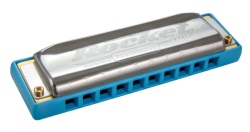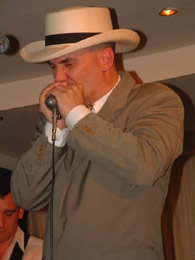Isolating Single Notes
 This information is given from a lip-pursed embouchure perspective, but may be useful for other embouchures. Audio files are based on a 10 hole diatonic harmonica in C major.
This information is given from a lip-pursed embouchure perspective, but may be useful for other embouchures. Audio files are based on a 10 hole diatonic harmonica in C major.
Newcomers to the harmonica can often find it difficult to play accurate single notes. Which is perfectly understandable. Let’s be honest, there really isn’t much to aim at. Plus the concepts of embouchure for accurate intonation and diaphragmatic breathing for tone have yet to be fully explored. Everyone has their own approach to gathering single note skills and some will find success sooner than others. If you are finding this skill elusive and frustrating however, don’t give up. It’s not that you can’t do it, just that you can’t do it yet. Give it time and you will get it. If this is your experience, welcome to the harmonica! Let’s run through a few ideas that may help you in your quest for isolating single notes.
Airtight
For the best tone and accuracy, first we need to eliminate any leakiness. This means placing your lips right round the mouth piece, with the corners of your mouth supportive but not rigid, and lips pushed slightly forward but not stiff. And drop that jaw. Remember also that each hole has dividers either side, so your target area is nearly twice as wide as your eyes might tell you. There is a margin around each hole. Pushing the harmonica into your lips will actually improve your accuracy, airtightness and tone.
Posture
Next you should remember to relax your posture. This includes your shoulders, neck, jaw and tongue. Make sure you’re not slumped or leaning on elbows either, as this compromises deep breathing from your diaphragm. If your cheeks are puffing in and out as you play, this probably means you are not moving warm air from deep down in your abdomen and your tone will suffer as a consequence. (more…)

 The keys to success
The keys to success How low can you go?
How low can you go?

